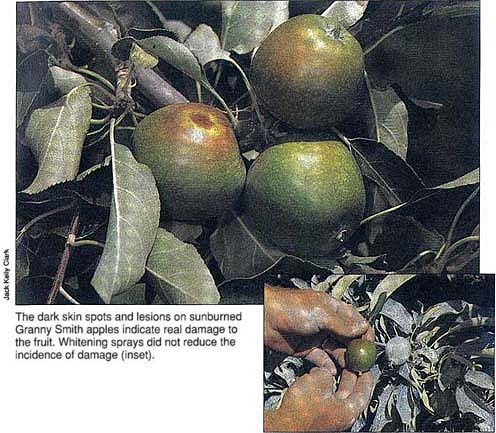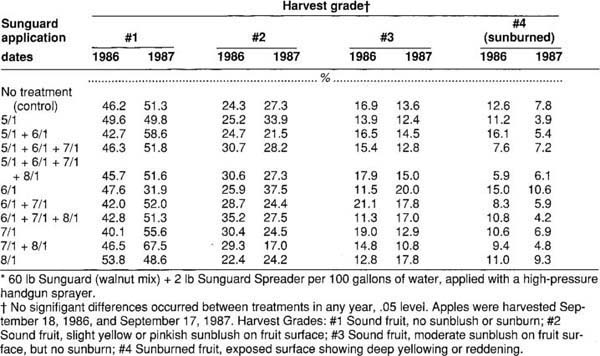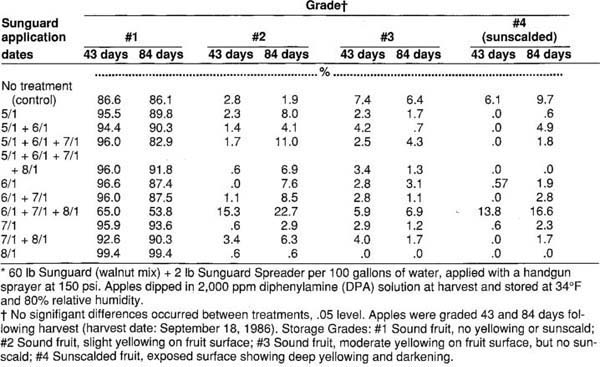All Issues
Effect of a topically applied whitener on sun damage to Granny Smith apples
Publication Information
California Agriculture 45(1):9-10.
Published January 01, 1991
PDF | Citation | Permissions
Abstract
Sunblush, sunburn, and sunscald injury of Granny Smith apple fruits is widespread and results in substantial economic loss when this cultivar is gra wn in the interior valleys of California. Topical, in-season applications of a whitening agent did not protect the crop from these heat-related injuries.
Full text
The dark skin spots and lesions on sunburned Granny Smith apples indicate real damage to the fruit. Whitening sprays did not reduce the incidence of damage (inset).
During the past 10 to 15 years, the green ‘Granny Smith’ apple cultivar has been planted extensively in the Sacramento and San Joaquin valleys of California. Unlike many other cultivars, the fruit quality of the Granny Smith (primarily its color and “fruit finish”)is not affected adversely by the area's hot, dry climate. The California Granny Smith Association estimates that 16,000 acres of Granny Smith are now planted in California.
Granny Smith growers use intensive orchard development and management techniques to obtain early and sustained production. Rootstocks that limit the trees' size and high-density planting promote early yields, and growers pick economically significant crops in the third growing season.
In the past, growers have bent and tied down scaffolds and year-old shoots when training young trees and managing older ones to encourage precocity and continued productivity. Such intensive training for early production combines with the natural bearing and leafing habits of Granny Smith to expose a high percentage of a tree's fruit to direct sunlight and intense heat during the growing season. Although Granny Smith is tolerant of normal ambient hot temperatures, such directed heat or light is excessive, and results in “sunblush” and “sunburn” when fruit are on the tree, and “sunscald” injury when exposed fruit are in storage. Sunblush and sunburn are usually visible at harvest.
Sunblush is not an industry standard, but a description adopted by Granny Smith apple packers. It is a visible yellowish to pinkish blush on the fruit surface caused by sun exposure. The flesh is not affected. Sun-blushed fruit are saleable, but represent a potential economic loss since their ultimate grade (and hence their value) may be reduced. They can be sold as the top grade (Extra Fancy), the second grade (Fancy), or the third grade (U.S. #1) depending on the amount of surface yellowing. Each grade reduction brings the value of the fruit down by several dollars per box.
Sunburn damage appears as a dark yellowing to browning of the exposed skin. Sunscald is a further darkening of the fruit surface that usually develops in storage on previously sunblushed fruits. Fruits having sunburn and sunscald are culled and sold to processors, who pay much less than the fresh fruit market.
Sunblush, sunburn, and sunscald injuries can affect more than 50 of the Granny Smith crop in an orchard. Besides the direct economic loss, growers and packers must also bear added sorting costs.
Previous research with some fruit and vegetable crops shows that commercially prepared whitening agents can be applied topically during the growing season to protect the crops from preharvest heat and sun injury. By completely coating the upper surface of the target fruit or vegetable with a sunlight-reflecting material, these products prevent the temperature of the exposed tissue from reaching damaging levels. In California, such materials are used to protect tomatoes and walnuts.
Up until initiation of our study, no one had investigated the effect of topically applied whitening agents on the sunblush, sunburn, and sunscald injury of apple fruits. Casual experience in other apple growing countries and in California suggests that whiteners may provide various degrees of protection. We undertook an experiment to determine the extent of protection provided by a topically applied whitening agent on sunblush, sunburn, and sunscald injury of Granny Smith apples at harvest and during a storage.
Methods
In 1986 and 1987, we conducted experiments to determine the effectiveness of applications of a commercial whitening agent (Sunguard) to pre vent or reduce sunblush, sunburn, and sunscald injury of Granny Smith apples. The experiment site in Tulare County in the southern San Joaquin Valley is home to substantial Granny Smith plantings. This area has a hot growing season, with daytime temperatures that commonly exceed 100°F during the late spring and summer months, the time when fruits grow rapidly and the new flesh is subsequently exposed to sun and heat. Serious sunblush and sunscald injury have been reported from this growing area. The formulation of Sunguard used to protect walnuts from sunburn injury was used for these apple tests. This formulation reportedly provides more heat protection than other Sunguard products.
In 1986, 5-year-old Granny Smith apple trees on M26 rootstock growing at Lindsay, California, were selected for the experiment. The trees were growing on a Madera loam soil with 8-by 16-foot spacing (340 trees per acre). These same experimental trees were used for our 1987 experiments. The primary scaffold branches of the experimental trees had been bent and tied down to wires spaced 20 inches apart and beginning 20 inches above the ground on a four-wire, vertical trellis. In 1986, the grower added a 48-inch horizontal cross-arm at 20 inches' height, which included wires at the cross-arm ends, at 12 inches from each end, and at the center. One-year-old shoots were trained out on the cross-arm wires for fruit production.
Both years, our whitening solution consisted of 60 lb of Sunguard and 2 lb of Sunguard Spreader in 100 gallons of water. We applied the solution topically to the entire tree to the point of runoff, using a handgun sprayer at 150 psi pressure. Applications were made on May 1 (as young fruits began bending down from a vertical position), June 1, July 1, and August 1 (approximately 6 weeks before harvest). These spray dates were used in several combinations to give 10 treatments and an unsprayed control (see table 1). Four single-tree replications of each treatment were used both years, and were arranged in a randomized complete block design.
TABLE 1. Effect of topically applied Sunguard on delayed the percentage of Granny Smith apples in each grade at harvest, Lindsay, California, 1986*
TABLE 2. Effect following two storage periods of in-season, topically applied Sunguard on delayed sunscald of Granny Smith apples graded #1 at harvest, Lindsay, California, 1986*
All fruits from each tree in the plots were harvested at normal maturity. Each fruit was graded 1 (sound fruit, normal green coloration, no sunblush or sunburn), 2 (sound fruit having sunblush, only a slight yellow or pinkish blush on any portion of the fruit surface), 3 (sound fruit having prominent sunblush on any portion of the fruit surface but no sunburn), or 4 (sunburned fruit, or sunscalded fruit following storage).
At harvest in 1986, we selected one 40 lb box of the No. 1 grade apples from each replication. We dipped the apples in a 2,000 ppm solution of diphenylamine (DPA) to prevent storage scald, and placed them into storage at 34°F and 80 relative humidity. At 43 and 84 days following harvest, we regraded the apples to determine whether any delayed sunscald had developed.
Results and discussion
At harvest, we found no significant difference in the percentages of fruit within any of the harvest grades for different treatments in either year of the test (table 1). Thorough whitening of the fruit surface was obtained with all Sunguard treatments immediately following application, but continued protection of the fruit surface depended on the number of re-treatments. As fruits increased in size, newly expanded tissue became exposed, so single or double treatments—especially those applied early in the growing season—provided poor season-long protection. Fruits from late treatments and from those combinations that included late treatments were completely white at harvest. Even these late treatment, however, did not reduce the incidence of sunblush and sunburn.
The progression of delayed sunscald continued in storage, again with no significant reduction for treated fruits (table 2). Additional yellowing and delayed sunscald became evident as storage time increased.
Summary
This experiment suggests that sunblush, sunburn, or sunscald protection of Granny Smith apple fruits on the tree or in storage cannot be obtained by up to four topical applications of this particular whitening agent. Thus, other cultural practices should be tested for their effects on sunburn or heat injury. Changes in tree fraining and pruning to promote natural shading of the fruit or irrigation management to avoid the tree stress that predisposes fruits to heat injury seem to be promising and are being studied.







